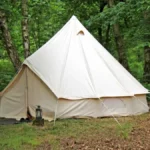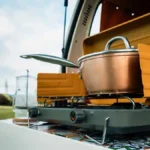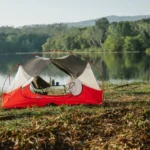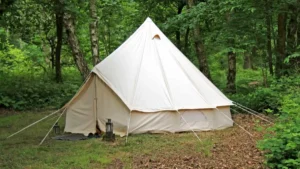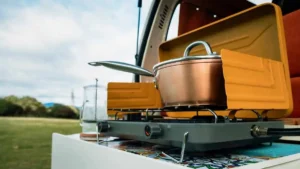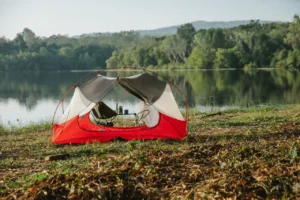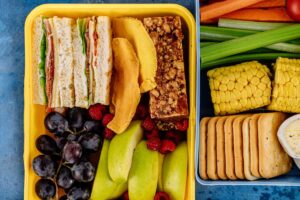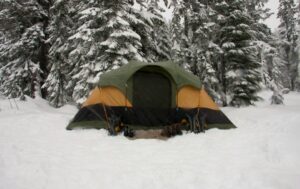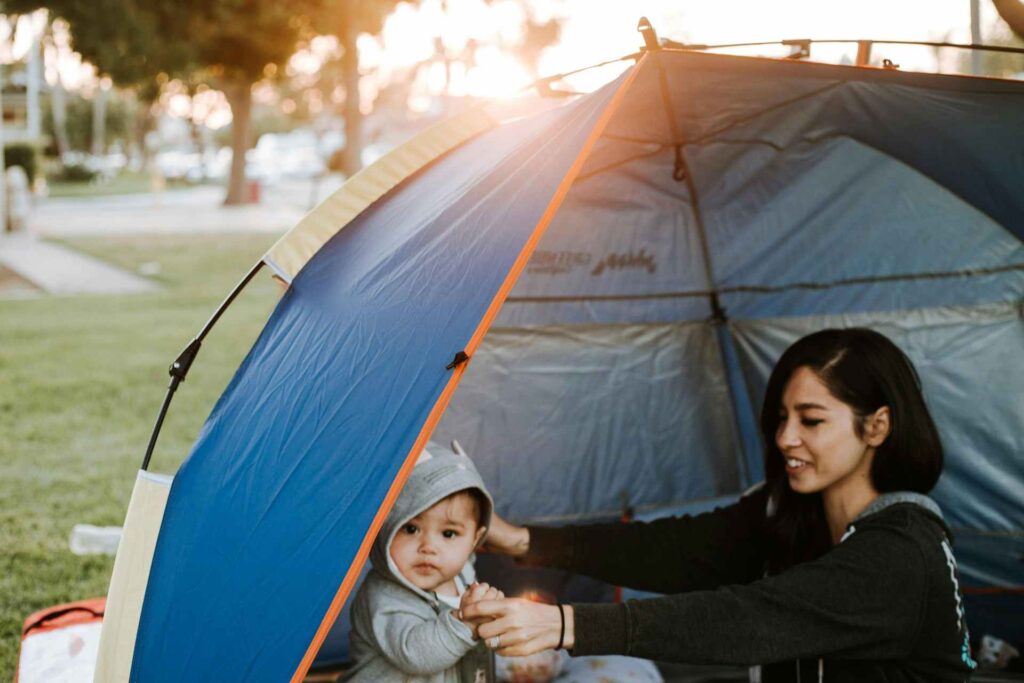
Omar Lopez / Unsplash
Taking your baby camping is a wonderful opportunity to make lasting memories and strengthen your bond in nature’s embrace. Yet, it’s no secret that camping with a baby brings unique challenges and things to think about for any parent.
Now, we’ll provide you with tips and proper gear for your baby so you can be prepared for your next camping adventure.
Key Takeaways:
- Planning and preparation are crucial for a successful camping trip with a baby.
- Choose baby-friendly camping destinations and consider the best seasons for camping with an infant.
- Set up a kid-friendly campsite with the right tent and safe sleeping arrangements.
- Master diaper changes and outdoor hygiene while camping.
- Pack the right gear, including weather-appropriate clothing and a portable changing station.
- Follow safety tips to create a secure environment for your baby.
Pre-Trip Planning: Ensuring a Smooth Camping Experience with Your Baby
This is one of the most important parts of camping in general, but when you have a baby on board, meticulous planning becomes even more crucial.
Make sure to list these important tips so you can check them before going on your trip.
But wait, If you’re a beginner make sure to read our post about tips and guides in camping for beginners to make you more equipped and prepared.
Choosing Baby-Friendly Camping Destinations
Here’s what you need to consider when choosing your camping destination for your baby.
- Amenities and Facilities – look for baby-friendly camp stations.
- Clean and accessible restrooms with baby-changing stations
- Family-friendly activities and attractions
- Near to grocery stores and medical facilities
Popular national parks and family-friendly campgrounds are often great options for baby-friendly camping experiences.
Timing Your Trip: Best Seasons for Camping with an Infant
Think about how the weather affects your baby. Stick to spring or fall when it’s not too hot or cold. Avoid hot or cold weather because it can be bad for your baby’s health.
Adults often get heat-related illnesses more often, but babies are actually at higher risk of heat exhaustion and stroke. Babies can get sunstroke mainly because they become dehydrated from being out in the sun too much.
If too cold, they might get hypothermia. We don’t want that. So if you’re new to camping make sure to research well, and apply the things you learn.
Creating a Baby Camping Checklist
Having a checklist is a must-have for every camper, especially if you’re a parent. To help you be prepared here are some essential items you should include:
- Diapers, wipes, and diaper rash cream
- Baby food, formula, and bottles
- Breastfeeding supplies, if applicable
- Clothing suitable for different weather conditions
- Blankets and sleep sacks are often forgotten camping essentials, so be sure to pack them.
- Baby carrier or stroller for easy transportation
- First aid kit with baby-specific items
- Baby-safe bug spray and sunscreen
- Toys and entertainment to keep your baby engaged
- Travel crib or portable bassinet for a safe and comfortable sleeping environment
Read more about the camping checklists with kids.
Now that you’ve chosen the perfect destination, determined the best season, and packed all the essentials, it’s time to learn how to set up a kid-friendly campsite.
Setting Up a Camping Tent with a Baby
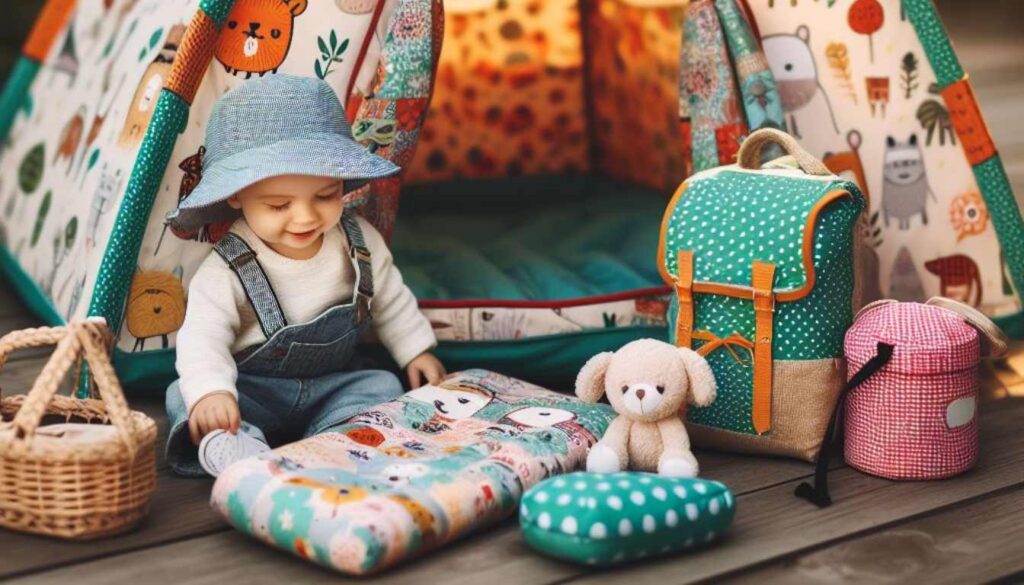
When camping with a baby, setting up a kid-friendly campsite is important. Here’s what you need to know:
Choosing the Right Tent for Family and Baby's Needs
- Pick a spacious tent with features like a vestibule for extra storage and changing space.
- Look for good ventilation to prevent condensation and ensure comfort.
- Opt for easy setup and durable, waterproof materials to handle weather conditions.
Safe Sleeping Arrangements
Ensure safe sleeping for your baby during camping by using a designated portable crib or bassinet that adheres to safety standards.
Set it up on a stable surface, free of any sharp objects. Opt for a suitable sleeping bag or sleep sack for your baby’s age and size and dress your baby appropriately for the temperature to avoid overheating.
Keep the crib clear of blankets and pillows to reduce suffocation risks, and always watch your baby closely while they sleep to keep them safe.
Keeping Baby Entertained with Camping Activities
Here are some infant-friendly camping activities to consider:
- Nature walks: Take your baby on strolls around the campsite or nearby trails, introducing them to the sights, sounds, and smells of nature.
- Sensory play: Bring along sensory toys, such as softballs, rattles, or textured toys, to stimulate your baby’s senses while outdoors.
- Outdoor picnics: Enjoy a picnic in nature with your baby, providing them with a chance to explore and experience different tastes and textures.
- Kiddie pool fun: Set up a small inflatable pool or a baby-friendly splash pad within sight of your campsite, allowing your baby to splash and play in the water.
- Storytime: Bring along age-appropriate books and read to your baby during quiet moments, introducing them to new stories and characters.
Remember, always supervise your baby closely during these activities and ensure their safety at all times.
Outdoor Diaper Changes and Hygiene
Changing diapers and maintaining hygiene while camping can be challenging, but with the right strategies, it can be easily managed. Follow these tips and tricks for mastering diaper changes while outdoors and ensuring proper hygiene for your baby during your camping trip.
- Choose a suitable diaper changing spot: Use a flat, clean surface like a changing pad or towel for your baby’s comfort and hygiene.
- Bring enough diapers: Pack sufficient diapers for the whole trip to avoid running out.
- Dispose of diapers properly: Seal dirty diapers in plastic bags to prevent odor and contamination. Keep a separate trash bag for diaper disposal.
- Practice good hand hygiene: Wash hands before and after changing diapers with soap and water, or use hand sanitizer.
- Pack baby-friendly wipes: Have enough wipes for easy cleaning. Choose wipes made for sensitive skin.
- Keep the diapering area clean: Change diapers frequently and clean thoroughly with wipes. Use diaper rash cream to protect the baby’s skin.
- Consider diaper liners: These thin, disposable sheets make cleanup easier by containing solid waste and preventing it from sticking to the diaper.
Packing for Baby-Friendly Camping
It’s important to pack the right gear for your baby to ensure their safety, comfort, and overall well-being. Here are some essential items to consider when preparing for your camping trip:
Weather-appropriate clothing
Choose weather-appropriate outfits for your baby, including breathable fabrics for warm weather and insulating layers for colder temperatures. Pack extra clothes for spills or accidents.
Keeping them Warm
During chilly nights camping, it’s important to keep them warm. Here are some tips to ensure your baby stays cozy:
- Dress your baby in layers to trap warmth. Start with a base layer made of moisture-wicking fabric, add a mid-layer for insulation, and top it off with a weatherproof jacket or onesie.
- Use a warm and snug sleeping bag designed for infants to keep them cozy throughout the night.
- Invest in a reliable baby sleeping bag liner for added warmth and comfort.
- Consider using a baby sleeping bag with a built-in hood or a cap to keep their head warm.
- Place a fleece blanket or a baby-sized heat pad under the sleeping bag for extra insulation
Portable Changing Station
Bring a compact and lightweight changing station for hygienic diaper changes on the go. Look for one with pockets to store diapers, wipes, and creams, making diaper changes easy and keeping your baby clean and comfortable during the trip.
Best Practices for Camping with Baby
When camping with your little one, safety is key. Here are some simple tips to keep them safe and happy:
- Fire Safety: Make sure your baby’s sleeping spot is away from the campfire. Always watch the fire and put it out completely before bed.
- Sun Protection: Keep your baby shaded by the sun. Use baby sunscreen and dress them in light, covering clothes. A shady spot or a baby-friendly tent works great too.
- Bug Protection: Keep pesky bugs away with baby-safe repellent. Look for natural options and apply them lightly to their clothes or stroller.
- First Aid Kit: Pack a simple first aid kit with band-aids, wipes, and any medicines they might need. It’s good to know basic first aid, like baby CPR, just in case.


